
Rosa and Josefa Blazek had been violin-playing conjoined twins from the Czech Republic who toured the USA within the Twenties. Rosa’s 11-year-old son, Franz Blazek, was featured prominently in ads used to advertise the twins’ performances.
Feeling exploited and embarrassed by the oft-used tagline “son of two moms,” a lawsuit was filed in Prepare dinner County, Illinois on Franz’s behalf towards the sisters’ supervisor in February 1922 searching for courtroom intervention to cease additional use of Franz’s title and {photograph} in newspaper ads.
In late March, nevertheless, Josefa contracted extreme pneumonia, which necessitated the twins’ admission to West Finish Hospital in Chicago. Rosa was “touched barely by jaundice,” however was in any other case wholesome. Appreciable thought was given to an try to sever the twins, however the concept was deserted after x-rays confirmed it inconceivable. Sadly, the sisters died on March 30.
As a result of the twins had organs in frequent and every had nursed Franz as a child, unprecedented questions arose whether or not the kid was the son of each girls and whether or not he ought to inherit their total $100,000 property—or simply his mom’s half. It was the eventual ruling in Franz’s lawsuit towards the supervisor, nevertheless, that may loom massive in a livid baseball card authorized battle waged by the Bowman Gum Firm in 1949.
The Gamers: Leaf Gum Firm
The Leaf Gum Firm was an business big in 1949, reporting fiscal yr gross sales in extra of $8 million (over $100 million at present) and boasting distribution to all 48 states. Since 1926, Leaf had offered each number of chewing gum possible and was the world’s largest producer of penny gumballs.
Leaf’s subsidiary firms had used illustrations of Main League ball gamers (and umpires) to assist promote its merchandise starting in 1934 with the Deitz Gum Firm “Ballplayers in Motion” set (designated R304 and known as the “Al Demaree Die Cuts” within the Buying and selling Card Database).

One other Leaf subsidiary, Overland Sweet Firm, produced “Baseball Rolls” from 1937 via 1942. This was a gum or sweet product rolled in a paper wrapper imprinted with a sketch of a Main League Baseball participant and containing a short biography. The set (R301) finally comprised 63 completely different wrappers. The biographical info, nevertheless, was typically obscure or inaccurate. For instance, the (undated) Invoice Nicholson wrapper indicated that the “standard outfielder made an enviable report with the Cubs final season. In addition to doing a bang-up job out in proper area, he made 27 residence runs which accounted for lots of runs batted in.” Nickelson, nevertheless, had by no means completed any season with 27 residence runs. (He did knock in “loads of runs” although.)
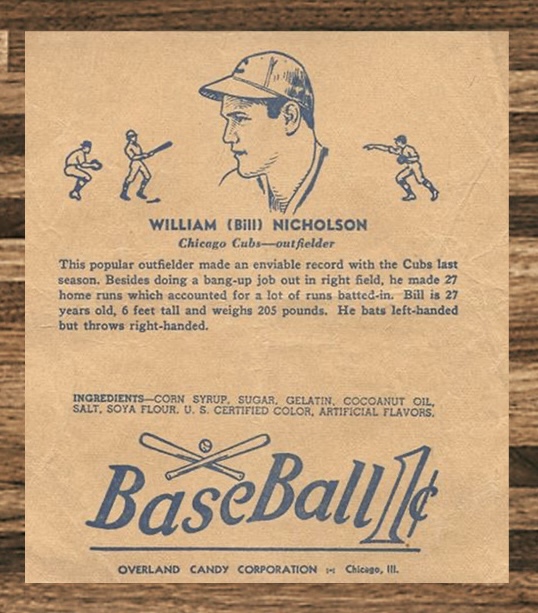
In response to Leaf’s Reply, Leaf utilized massive pictures of baseball gamers as premiums for gum gross sales in 1941 and in a part of 1942. Leaf hooked up a 5”x7” {photograph} of Dodgers first baseman Dolph Camilli as Exhibit D to its Reply. (This particular card is not among those listed on Trading Card Database for Camilli. It’s unclear how these had been really distributed, whether or not the set was catalogued, or what different playing cards might have been produced.)
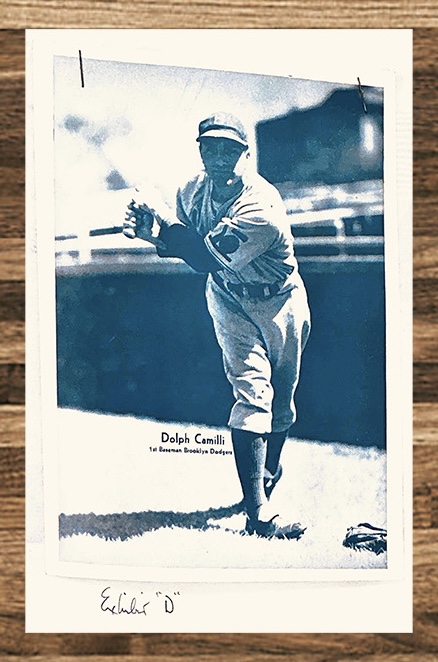
Leaf introduced its plans to compete with Bowman for nationwide baseball card supremacy beginning in 1949. Promotional supplies for Leaf’s “All-Star Footage Bubble Gum” product knocked the dimensions and high quality of Bowman’s black-and-white 1948 launch. Specifically, Leaf boasted their product would come with “over 300 Main League stars from this yr’s squads” with playing cards of “full ‘lagging measurement’ in beautiful, sensible colours” and the title of every participant “proper on the entrance of the cardboard.” Moreover, the backs had been set to incorporate “sportswriters’ full 1949 histories of all gamers.” Leaf printed the playing cards themselves and bought extra printing tools prematurely of its 1949 baseball problem.
Offered at retail in five-cent packs containing three items of gum and 5 image playing cards, Leaf provided its 24-pack bins at wholesale for 72¢ every, with a minimal order of three 20-box circumstances. (The $14.40 value per case is roughly $190 at present.) As a bonus, Leaf additionally packed a 5”x7” photograph of Babe Ruth (who had handed away on August 16, 1948) in every field as a reward for the client of the final pack.
The 1949 Leaf playing cards had been 2-3/8” x 2-7/8” (roughly 32% greater than the 1949 Bowman playing cards). All 16 groups had been to be represented. Leaf shipped its first truckload of All-Star Gum product to Boston, Massachusetts on March 14, 1949. The Bowman Gum Firm was not happy.
The Gamers: Bowman Gum Firm
Bowman Gum Firm (when referred to as Gum, Inc.) produced “Play Ball” units from 1939 via 1941. The 1939 Play Ball set included 15 groups (no Cubs) and used black-and-white pictures with no title on entrance. The set totaled 161 playing cards (no card 126 was issued) regardless of the cardboard backs indicating there have been 250 playing cards within the set. The 1940 set included 240 playing cards and all 16 groups. The playing cards used black-and-white pictures, however now included the title on entrance. The 1941 Play Ball set was pared right down to 72 playing cards and excluded the Cubs all collectively, together with the remaining 15 groups, with two playing cards displaying Boston “Bees” and later playing cards up to date to indicate the staff’s title change to “Braves.”
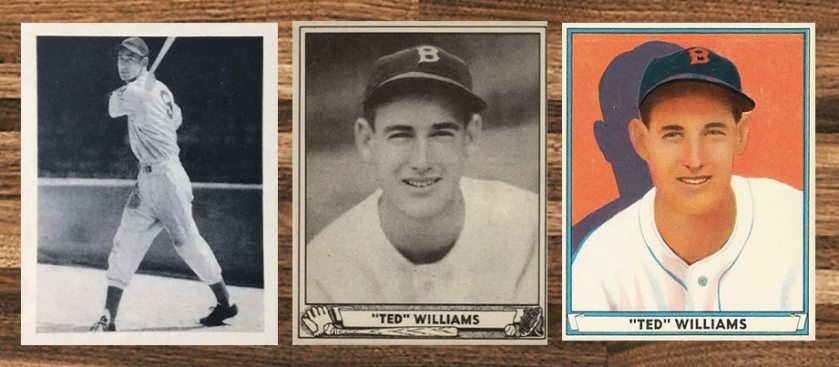
Nonetheless, the manufacture of bubble gum was discontinued throughout World Battle II as a result of unavailability of pure latex (a vital ingredient in Bowman’s gum), so no Play Ball units had been issued after 1941. The Play Ball units had been produced in a bigger measurement (2-1/2” x 3-1/8”) than the Bowman units beginning in 1948.
With the struggle over and rations lifted, Bowman revived its baseball card gum product within the spring of 1948 as they entered contracts with 48 Main League Baseball gamers that gave Bowman unique rights to problem playing cards at the side of its gum merchandise for one yr. That 48-card 1948 Bowman set was issued in black-and-white with smallish playing cards sized 2-1/8” x 2-1/2”. Of the 16 Main League groups on the time, solely 10 had been represented. (There have been no playing cards issued for any gamers on the Pink Sox, Cubs, White Sox, Tigers, Browns, or Senators.) Bowman’s packs contained three items of gum and 5 playing cards and had been offered at retail for 5 cents. The packs had been first distributed in June 1948 and offered via September. Gross sales had been substantial – the $361,000 income attributed to the 1948 Bowman problem can be equal to about $4.7 million at present.
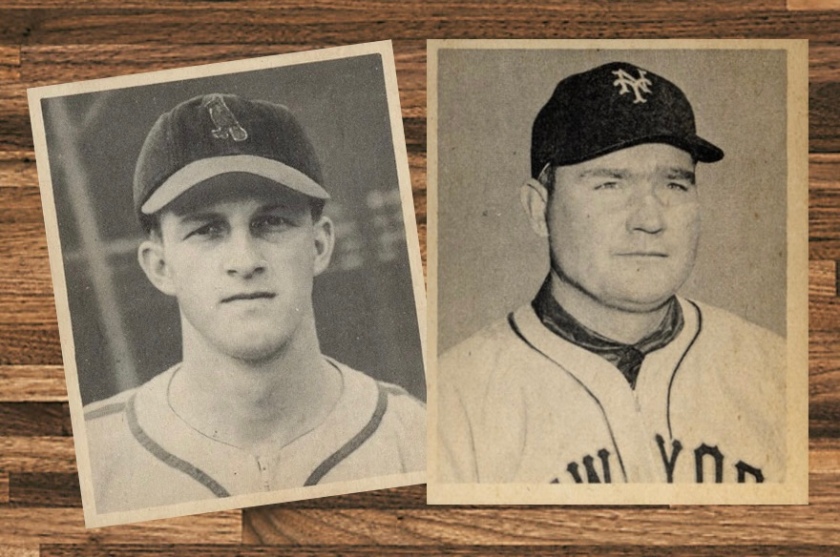
Getting ready for 1949, Bowman entered contracts with 240 Main League gamers (and 36 gamers of the Pacific Coast League) within the fall of 1948. These contracts referred to as for the cost of 1 greenback on the time the contract was signed and the stability of $99 to be paid on January 15, 1949. Shortly after signing these contracts, Bowman introduced to the business that they’d be producing the bigger set for the approaching season set for distribution by April 1, as “kids eagerly awaited the opening of the particular league contests.” [Although $100 per player may not seem necessarily substantial, in the aggregate Bowman had expended $24,000 (in excess of $300,000 today) to procure the rights for its 1949 set and paid an additional $12,000 to Art Flynn, who obtained the signed contracts for Bowman.]
Opening Salvo
Bowman had their attorneys hearth off a gravely worded letter on Wednesday, March 16, 1949 to the Leaf Gum Firm, which learn:
“Gents:
We now have been retained by Bowman Gum, Inc. of Philadelphia, Pennsylvania, who’ve unique contracts with numerous baseball gamers for the usage of their footage in reference to the sale of Bubble Gum.
Our shopper advises that you’ve information of the existence of those unique contracts with it, however that you’re nonetheless now delivery and promoting Bubble Gum in packages containing footage of ball gamers with whom our shopper has such contracts. You might be accordingly notified, and until you instantly stop and desist from any additional shipments or gross sales of Bubble Gum containing any such footage, we will institute acceptable motion towards you for injunctive aid and damages. Until we obtain your assurance instantly upon receipt of this letter that no additional shipments or gross sales containing such footage will likely be made, we’ll institute proceedings directly.”
Yours very really,
AARON, AARON, SCHIMBERG & HESS
By: (sd) Lewis Schimberg”
Regardless of these threats of authorized motion, vehicles saved leaving Leaf’s manufacturing unit at 1155 N. Cicero in Chicago loaded with circumstances of All-Star Gum. So, Bowman wasted no time commencing authorized motion towards Leaf.
Bowman Lawsuit Filed
On Monday, March 21 Bowman filed its grievance towards Leaf within the Superior Court docket of Prepare dinner County in Chicago. A number of particular person gamers had been additionally named as plaintiffs, together with Johnny Mize, Sid Gordon, Whitey Lockman, Sheldon Jones, Larry Jansen, Walker Cooper, Willard Marshall, Clinton Hartung, John Kerr, Dave Koslo, William Rigney, Robert Thomson, and Jack Lohrke. (Hereinafter the group of plaintiffs—which grew because the case progressed—will likely be known as “Bowman” or “Plaintiffs.”) That the verified grievance was signed by Bowman’s Secretary Harry Shapiro on March 18 and participant agent Artwork Flynn on March 19 absolutely signifies that Bowman didn’t count on Leaf would adjust to the “stop and desist” letter.
Plaintiffs alleged of their Criticism that Leaf knew that Bowman had entered into unique contracts with the ball gamers—however went forward with the manufacture of their baseball card gum product, anyway. As was needed to hunt a everlasting injunction, Bowman (dramatically) asserted that Leaf’s competing product would go away Bowman unable to promote its personal baseball card gum in 1949 and push the a lot smaller firm to the precipice of monetary break. Bowman claimed it was “certainly a really small producer within the gum area, although its enterprise constituted an especially helpful one.”
Accordingly, Bowman requested the courtroom to enjoin (legally prohibit by means of injunction) Leaf from “promoting, delivery, promoting, or providing on the market or distribution, straight or not directly, at, from or to anyplace in the USA, any type of chewing gum, together with bubble gum, in packages containing footage of any of the baseball gamers listed of their grievance.” Plaintiffs additional requested that Leaf be ordered to destroy all packs, wrappers, and playing cards that had already been manufactured. Lastly, Bowman requested for financial damages.
Leaf’s Reply
Leaf admitted of their Reply that that they had first shipped circumstances of All-Star Gum into Boston, Massachusetts, on or about March 14, 1949 (which ought to put to relaxation any interest hypothesis that Leaf started distributing this problem in 1948).

For his or her protection, Leaf claimed that no “proper of privateness” hooked up to the ball gamers as a result of they had been public figures; denied that Bowman may legally implement their “unique contracts” with any of the ball gamers; emphasised that solely two of the named plaintiffs (Johnny Mize and William Rigney) appeared on the playing cards issued by Leaf; and denied having any advance information in regards to the measurement, shade, or contents of Bowman’s deliberate 1949 baseball card problem. Of the 49 playing cards issued by Leaf within the first collection, 33 had been contracted to Bowman, 15 of whom had been plaintiff within the topic lawsuit.
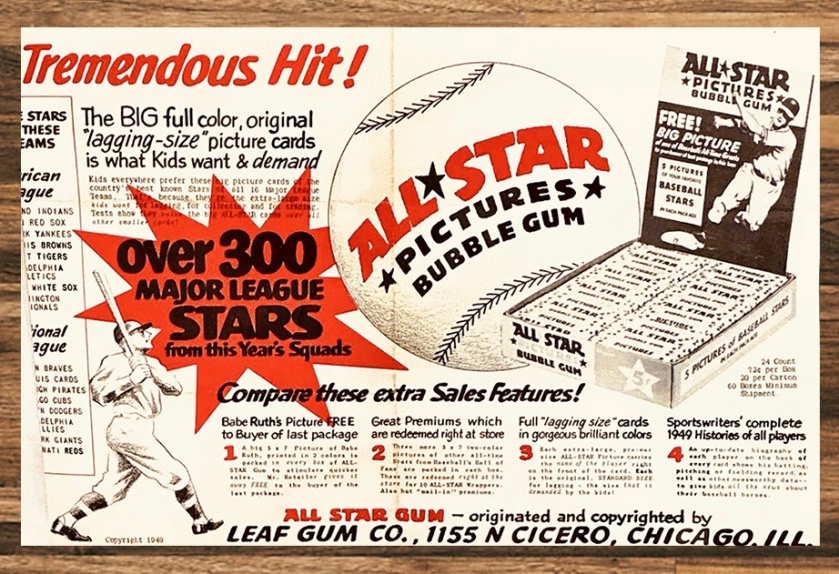
Leaf additional claimed that Bowman had not complained about Leaf’s soccer playing cards issued within the fall of 1948 that had been packaged with three sticks of gum and 5 playing cards, similar to Bowman’s 1948 soccer problem. Moreover, early 1949 Leaf problems with “Knockout” boxing playing cards and basketball playing cards drew no protest from Bowman, which had additionally issued related units. Leaf additionally emphasised that Topps’ 1948 “Hocus-Pocus” set included a number of baseball gamers, together with a Lou Boudreau card hooked up as an exhibit to their reply, and Bowman had not made any grievance concerning the Topps product.

Lastly, Leaf indicated that their baseball collection had “been available on the market for numerous weeks; and to the information of defendants, company plaintiff has not but positioned on the market a product of an identical nature.”
Put Up Yer Dukes
The matter was assigned to Decide Frank Padden, who in flip, appointed a Chancery Grasp to listen to proof and provide his opinions as to a therefrom. Most frequently, a grasp in chancery is a practising legal professional, not a choose. Within the Bowman case, the grasp’s duties had been handed over to Herbert Paschen, a Chicago legal professional who was unsuccessful in a subsequent bid for Illinois governor and was finally elected as a Prepare dinner County choose in 1962. The events submitted their proof on April 25, 1949 after which exchanged blows over two days of oral argument Might 2 and Might 3.
Bowman led with their strongest argument, specifically that Leaf was infringing on the 237 unique participant contracts it had begun assembling in October 1948. Bowman had first shipped its product on March 15, 1949 (at some point after Leaf’s first truckload of All-Star Gum set off for Boston) and by the point of argument, was being distributed to all 48 states. Gross sales to that time totaled $71,000 (about $940,000 at present). Their first collection contained “roughly 108 completely different footage” with extra collection to be launched at deliberate three-week intervals. Just like the yr earlier than, Bowman packs included 5 playing cards and three items of gum.
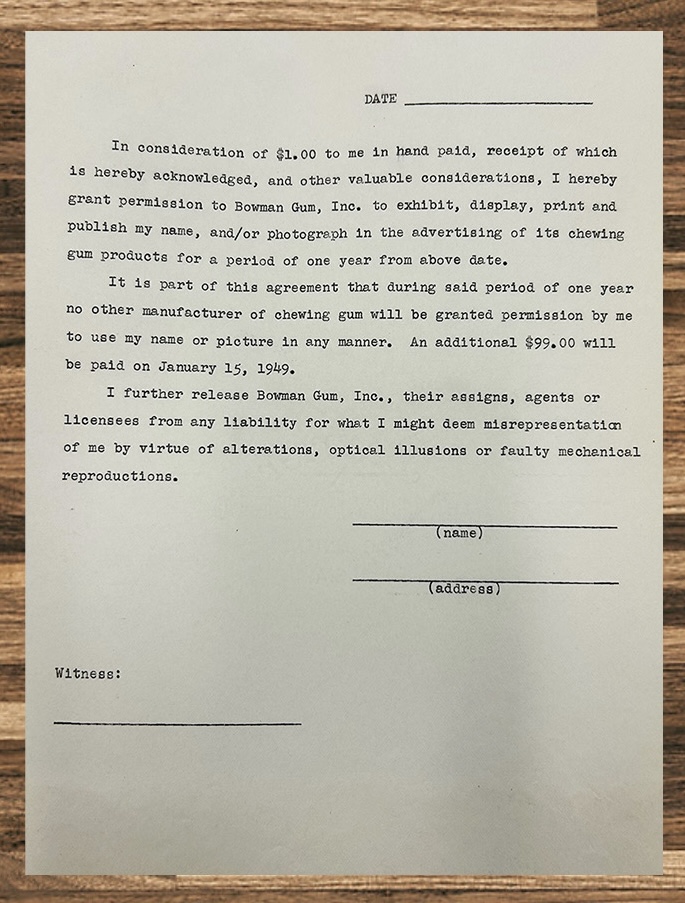
Leaf freely admitted it had no contracts with any of the gamers, nevertheless, they argued that as a result of Main League gamers had been public figures, the general public’s curiosity within the distribution of images and information about them outweighed the gamers’ privateness. The pictures utilized by Leaf had been obtained via a number of sources, however the majority had been obtained from photographer Emmett “Flash” Wiggins.
Pursuant to the on-field press passes granted by the Cubs and White Sox, Wiggins had amassed an exhaustive file of participant pictures (some 50,000 negatives) and counted the Cubs, the Sporting Information, Hillerich & Bradsby, Common Footage, and Pabst Blue Ribbon Beer Firm, amongst his greatest clients. Wiggins believed he had given out roughly 5000 copies of pictures to ball gamers over the previous a number of years. He additionally made his pictures obtainable to the general public at 5 {dollars} every (about $66 at present!) or $7.50 (about $100 at present) per hundred for the gamers themselves. Many of the pictures had been posed.
Wiggins testified that not one of the ball gamers had ever informed Wiggins that the images may not be used commercially (although he admitted he didn’t essentially advise them he was promoting their footage). Furthermore, there have been no printed restrictions on the usage of any such pictures and every of the photograph suppliers knew that Leaf was buying the images for the manufacturing of bubble gum playing cards.
Bowman answered that as a result of footage of celebrities had been extremely sought-after by collectors, the rights to make use of the images had been a profitable supply of earnings for the people. Bowman dismissed as disingenuous Leaf’s assertion that their playing cards had been merely ephemeral biographies or information objects. Bowman cited to Edison v. Edison Polyform Firm, a New Jersey case from 1907 through which Thomas Edison efficiently prevented the defendant firm from utilizing his image in promoting its merchandise, as a result of he was not concerned in any way within the firm itself.
Though Leaf deliberate a set of 300 playing cards, simply the primary 49 All-Star Gum playing cards had been distributed to that time (albeit throughout 80% of the USA) and Leaf’s attorneys submitted an uncut sheet of that first collection into proof. Leaf claimed that the All-Star Gum hit the market in March 1949 and complete gross sales of that preliminary collection had approached 145,000 bins. (At 72¢ per field, the $104,000 price of product offered to that time can be roughly $1.38 million at present.)
Leaf argued additional that the sale or publication of uncopyrighted pictures, together with these taken by Wiggins, entered the general public area. Accordingly, the pictures offered to Leaf for its card set had been free for use for any industrial objective, together with replica and promoting. As a result of Wiggins took the images at his personal expense, he had the implied proper to regulate the publication, distribution, and resale of the images. Authority was clear {that a} single sale constituted publication.
Bowman responded that that as a result of Wiggins took the gamers’ pictures as a press photographer—not a industrial photographer—Leaf had acquired pictures as results of a breach of confidence. Bowman additionally accused Leaf of appropriating its advertising and marketing plans by promoting the same amount of playing cards and gum in a five-cent bundle (regardless of Leaf having used the identical configuration for its 1948 soccer card packs).
Bowman argues that the “proper of privateness” idea launched by Samuel Warren and Louis Brandeis within the Harvard Regulation Evaluate revealed in 1890 utilized in Illinois. Nonetheless a growing space of regulation within the Nineteen Forties, the courts in 15 states, the District of Columbia, and Alaska (which was not but a state) had formally acknowledged the correct. Three extra states had enacted statutory proper of privateness legal guidelines. Conversely, three states (Rhode Island, Wisconsin, and Michigan) had affirmatively held that no such proper of privateness existed. Illinois was with out revealed precedent concerning the correct of privateness, nevertheless.
Leaf claimed, nevertheless, that the Warren and Brandeis article expressly asserted that the correct to privateness ceased upon publication and that any proper of privateness didn’t prohibit publication of a matter that was of public or basic curiosity. Leaf cited to O’Brien v. Pabst Blue Ribbon case, a case through which Davey O’Brien, a teetotaling skilled soccer participant, was not allowed to object to his title and {photograph} being utilized in a soccer schedule given away by the Pabst brewery. As a result of O’Brien had posed willingly for the photograph, “the publicity he received was solely that which he had been always searching for.”
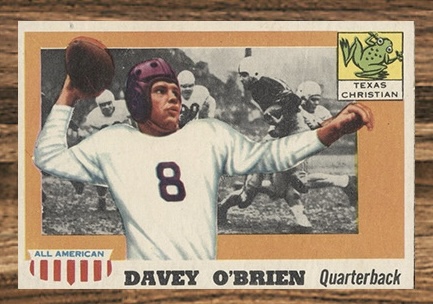
Leaf additional accused Bowman of together with footage of well-known generals and its struggle playing cards with out their consent. It additionally claimed that the New Jersey Edison case was not probative in that his title was utilized by utility firms in Chicago, New York, Boston, and elsewhere, with out his having any reference to these entities. Leaf even went up to now to assert that the “Bowman” title was not unique in that Chicago’s Bowman Dairy Firm was ready to make use of the title with out menace of confusion.

The Leaf attorneys as an alternative relied on the 1935 Hanna case through which the Fifth Circuit discovered that fame was not merchandise because it utilized to utilizing well-known baseball gamers to promote mannequin bats, “it could assist neither sportsmanship nor enterprise to carry a sale of a well-known title to the best bidder.” [This seemingly antiquated concept has obviously changed over time and even in the 14 years that had passed since the Hanna case was decided.]
Leaf lastly claimed that Bowman had tried to monopolize the sale of gum in violation of the federal antitrust legal guidelines by trying to “cease distribution by others of fabric regarding our nationwide pastime. If the idea of fresh palms means something in fairness, jurisprudence requires software right here. The perpetrators of monopoly have come into fairness for assist and help and their petition needs to be denied.”
Affidavits submitted by Bowman had been additionally considered. For instance, Bowman gross sales agent Charles Meek averred that Leaf started circulating promotional supplies round Chicago stressing that their playing cards had been massive and that the children would need them “for lagging, amassing and for buying and selling.” (Lagging was a betting sport through which youngsters would toss their playing cards in an try to face them up towards a wall.) Meek believed that the Leaf playing cards would diminish Bowman’s gross sales as a result of they had been bigger, and since the playing cards had been offered in collection, youngsters would like to attempt to full Leaf’s first-to-market problem. Meek then executed a supplemental affidavit on March 30 indicating he had personally seen “not lower than 100 bins of the defendant Leaf’s product All-Star bubblegum” at a Chicago wholesaler and later informed the cargo, “contained 1000 bins of defendant’s product, every field containing 24 packs, or 24,000 packages in all.” Meek additionally testified that Bowman’s unique intention was to withhold “distribution till on or in regards to the 1st day of April as a way to coincide with the opening of the baseball season.”
The Evocation of Franz Blazek
Bowman’s argument culminated within the Blazek case as they claimed that Illinois had acknowledged the “proper of publicity” when the Prepare dinner County Court docket dominated in favor of Franz Blazek in 1922. In Blazek, a brief injunction had been granted on the grounds that the correct to publish Blazek’s {photograph} to assist promote his mom’s public appearances was a helpful property proper and utilizing that {photograph} with out his permission (or cost) was a violation of the kid’s proper of property and privateness.
Leaf objected to any reference to the Blazek case, nevertheless, as a result of the opinion was unpublished; all of Bowman’s citations to Blazek got here from a secondhand account of the case present in a reporter revealed in 1930; and the precise courtroom file had mysteriously disappeared. A diligent search was made for the courtroom file; nevertheless, the clerk of the Circuit Court docket of Prepare dinner County suggested it has been lacking for a substantial interval.
With out an official opinion, Leaf posited it was inconceivable to find out the Court docket’s reasoning for its ruling and recommended it was potential the choice was primarily based on procedural causes and never on the deserves of the case. Moreover, the allegations in Blazek gave the impression to be based on misrepresentation and never the correct of privateness. Leaf argued that Illinois had not adopted the correct of privateness; they had been merely publishing pictures and biographies of newsworthy public figures; and no different tort towards the ball gamers had been dedicated.
Finally, the problem on this case was not whether or not possession of the images or title to the images was in Leaf’s hand, however whether or not Leaf had the correct to breed the images. Moreover, questions existed whether or not Leaf had the correct to regulate the replica of the images as a result of that they had been beforehand revealed. Bowman summarized its argument by means of analogy: an individual who purchases a e-book has the correct to learn it himself, learn it aloud to others, lend it to others, hire it to others, or promote it to others. However he doesn’t have the correct to breed it—similar to the images bought by Leaf.
Philadelphia Issues
As a result of Leaf was making shipments into territories apart from Boston, Bowman and several other particular person gamers, together with Warren Spahn, filed an identical motion in Philadelphia (the place Bowman was primarily based) towards an area dealer, Jack Bendon, and different wholesalers and retailers searching for to bar the sale and distribution of Leaf merchandise. The pleasant hometown choose issued a brief restraining order that prohibited Leaf from promoting playing cards with its gum wherever in the USA, an order that strained the bounds of enforceability.
As quickly because the Philadelphia courtroom issued the decree on Might 6, 1949, Bowman revealed statements in commerce papers reporting that the injunction had been granted towards Leaf, however didn’t point out that Prepare dinner County had already denied its petition for a brief injunction on April 1 or that this different matter was nonetheless pending in Illinois.

Regardless, this Pennsylvania ruling had no impact in Illinois and didn’t cease Leaf from persevering with to ship its All-Star Gum everywhere in the nation.
Paschen Assertion
Paschen reviewed the proof, testimony, and briefs submitted by the events and issued his thorough Grasp’s report on August 11, 1949.
As of the date of the hearings, Leaf had used footage and biographies of 49 completely different baseball gamers in its packages of gum, 33 of which had been gamers beneath contract with Bowman, and 15 of these had been plaintiffs on this lawsuit. Leaf admitted it had no written permission from any of the baseball gamers to make use of their footage however contented that the permission was not needed as a result of the baseball gamers had been public figures and used the gamers in groups’ publicity and constituted information worth to the purchasers of the gum.
Paschen famous that pictures utilized by Leaf had been procured via promoting companies and photographer Flash Wiggins, who confirmed he had no written permission from any participant to promote the pictures. Wiggins additionally confirmed that he had by no means talked about to any participant that the images had been for use commercially. Furthermore, the images had no printed restrictions on them. Lastly, there was no displaying that Leaf procured the {photograph} by fraud.
Paschen discovered there was nice battle among the many authorities as to the correct of privateness and highlighted that a number of states, together with Rhode Island, Michigan and Wisconsin, had discovered that no proper of privateness existed. Plaintiffs contended that the correct of privateness had been established in Illinois within the Blazek v. Rose choice, however that the Court docket’s official opinion couldn’t be situated.
Finally, Paschen held the opinion that Leaf’s use of the images and biographies of the baseball gamers didn’t represent a violation of the legal guidelines of the State of Illinois and couldn’t be enjoined. Accordingly, he really useful that an order be entered dismissing the trigger for lack of fairness.
The Court docket’s Decree
Deep within the throes of the offseason, Decide Frank Padden issued his written ruling on January 20, 1950, after having thought-about the Grasp’s reviews. Ignoring the Grasp’s opinions, Decide Padden dominated as an alternative that Leaf “had and haven’t any proper to make use of for industrial or promoting functions the names and footage of public figures resembling baseball gamers with out their consent.” Accordingly, Bowman was entitled to a decree of everlasting injunction and damages towards defendants.
Leaf was thereby perpetually enjoined and restrained from delivery, promoting, or providing on the market to be made anyplace within the State of Illinois chewing gum containing footage of the ball gamers concerned as plaintiffs with out first acquiring the categorical consent.
In an order entered on Might 19, 1950, Decide Padden dismissed the defendant’s enchantment and a cross-appeal filed by Bowman. Accordingly, this ruling was by no means analyzed by the appellate courtroom.
Lengthy after the case had been closed, attorneys for Bowman filed a movement in August 1951 that allowed them to take away the unique contracts from the courtroom file, which presumably included the signatures of gamers resembling Johnny Mize, Bob Feller, Warren Spahn, Stan Musial, Yogi Barra, Phil Rizzuto, Hank Sauer, and others. Though the order required that photostatic copies be substituted, no such copies had been discovered within the courtroom file pulled from the archives.
Bowman v. Leaf: The Aftermath
After the decisive victory for Bowman, the matter was referred again to the Grasp to award financial damages to Bowman and every of the person plaintiffs. No paperwork was discovered within the courtroom file, nevertheless, so it’s unclear whether or not this occurred and in that case, what damages might need been assessed. Regardless, Leaf thereafter settled with Bowman and agreed to withdraw from the baseball card enterprise till via January 1, 1951. Leaf tried in useless to work out preparations with Topps to share printing rights, however Topps was not . Leaf lastly reentered the baseball card market in 1960.
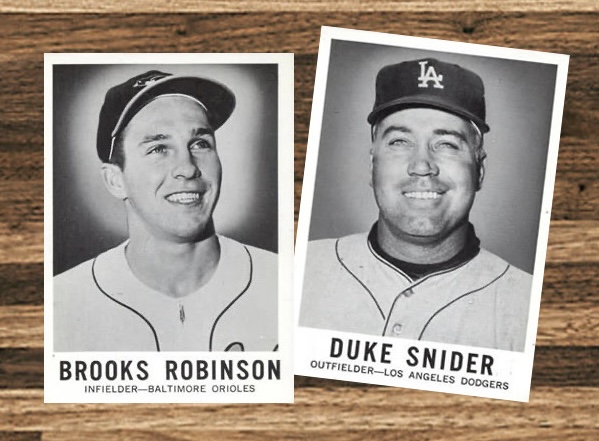
Because it pertains to the interest, the proof and admissions within the courtroom paperwork make it clear that Leaf started distributing its All-Star Gum playing cards on March 14, 1949. Accordingly, this set shouldn’t be thought-about a “1948-1949” problem. Regardless of the 1948 copyright on the backs of playing cards, none of those playing cards had been issued to the general public in 1948. Furthermore, it appears possible that Bowman would have commenced authorized motion a lot earlier if Leaf had been selling or distributing the playing cards in 1948.
Additionally, though the uncut sheet of 49 playing cards was not discovered within the courtroom file, it appears logical that Leaf produced two 49-card sheets that contained the 98 playing cards issued. Primarily based on the courtroom paperwork, the second collection was first distributed after Might 3. Though the courtroom information don’t present the identities of the gamers distributed in every collection, the intense shortage of 49 playing cards gives the interest an informed guess. Furthermore, there may be not an excellent cut up between the playing cards bearing the 1948 copyright and the 1949 copyright, so it seems that a minimum of one sheet of Leaf playing cards was printed with a mixture of each 1948 and 1949 copyright dates on the cardboard backs.
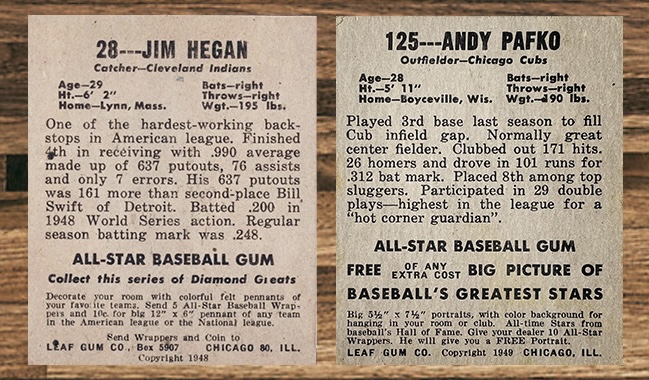
Lastly, that Bowman included the gamers’ names on the entrance of its later-issued collection of 1949 playing cards, suggests this was in direct response to Leaf’s playing cards and promotional supplies emphasizing that their playing cards included the gamers’ names on entrance.

Though Decide Padden’s 1950 decree discovering in favor of Bowman didn’t cite the Blazek case by title, the unhappy saga of Franz Blazek and a pair of violin-playing conjoined twins could have performed a task in giving Bowman its desired baseball card supremacy—effectively, a minimum of for 1950.
SOURCES/NOTES
Bowman Historical past
Bowman’s grudge towards the Cubs was evident its Play Ball points 1939-1941 and its 1948 namesake problem. Not one of the 5 Cubs playing cards issued in 1940 featured lively gamers. The Johnny Evers, Charlie Grimm, and Tony Lazzeri playing cards had been marked with “Former Main League Star” on the reverse. The Frank Probability was marked “Former Main League Star and Supervisor.” (Johnny Evers and Charlie Grimm may even have had the “and Supervisor” added.) The George Uhle was marked “Coach” regardless of his one-year stint as Cubs pitching coach having led to 1939. No Cubs had been included within the 1948 Bowman set.
Bowman didn’t have written contracts with any particular person skilled soccer gamers, however had obtained written, non-exclusive permission from the commissioner of the Nationwide Soccer League and numerous membership house owners. Arthur Flynn, who had obtained permission for Bowman, testified that the NFL and the person groups received loads of publicity from the product. Gross sales of the 1948 soccer collection totaled 246,000 bins. Equally, Bowman didn’t have any contracts with the NBA gamers, however as an alternative Flynn had procured unique rights from the president of the Nationwide Basketball Affiliation to make use of footage of the gamers. No cash was paid for this. The inducement was publicity for the league.
Pure latex was critically restricted as a result of Japanese occupation of rubber-producing areas in Southeast Asia throughout World Battle II. The latex was wanted for the struggle effort in producing tires and fuel masks, so civilian use was strictly curtailed. This rationing was additionally largely chargeable for all chewing gum producers switching to artificial gum bases post-war.
Leaf Historical past
Though some sources point out the Overland R301 set was first issued in 1936, it seems that the preliminary manufacturing order was made by Sol Leaf to the Kyrle A. Sheffer Firm on or about February 8, 1937. The correspondence confirming the deal included an preliminary $400 cost for printing plates, analysis, and paintings. (Which appears to recommend that Sheffer was chargeable for designing and writing the copy for every of the wrappers.) The agreed-upon value for the wrappers can be three million heaps at $.23 per thousand. The preliminary collection was to encompass 48 completely different baseball gamers. A soccer collection was produced as effectively, offered from 1940 to 1942.
Buying and selling Card Database labels the R304 set “1934 Al Demaree Die Cuts” and consists of no reference to Deitz Gum Firm or “Ballplayers in Motion” as indicated on the wrapper included as Reveals E1 and E2 to Leaf’s Reply. Primarily based on the gamers who seem within the set and the groups with whom every is pictured, it appears extra possible this was a 1934 problem, not a 1938 problem because the attorneys claimed in Leaf’s Reply.
Leaf’s promotional supplies didn’t point out any attribute or attribute of the gum, which helps the notion that the baseball playing cards had been the product, and the gum was a throw-in.
All proof from this case, together with Leaf’s personal admissions, unequivocally confirms that the Leaf playing cards had been first distributed in March 1949, to time availability with the opening of the 1949 season. Leaf had beforehand distributed its soccer playing cards in 1948 in the course of the soccer season. This could put to relaxation any persevering with questions whether or not the playing cards had been distributed in 1948 and that the interest ought to merely think about this a 1949 problem.
Leaf’s technique and/or protection was not with out advantage, particularly as proper of privateness and publicity rights regulation was persevering with to develop.
Circumstances
Edison v. Edison Polyform Mfg. Co., 73 N.J.Eq. 136, 67 Atl. 392 (1907). Well-known inventor Thomas Edison had developed a topical medicinal meant to alleviate neuralgic ache that he referred to as “Polyform.” It was first made for private use and by no means offered to the general public. Edison offered the formulation outright for $5,000 in 1879. Following a collection of failed makes an attempt to market the product, defendant started promoting it in bottles with a label depicting Edison and utilizing the next declare, “Edison’s Polyform. I certify that this preparation is compounded in response to the system devised and utilized by myself. Thos. A. Edison.” The courtroom granted an injunction that restrained defendant from holding out that Thomas Edison has any reference to or half within the defendant’s enterprise.
Blazek v. Rose, Cir. Ct. Prepare dinner County, Sick. (1922),not reported however cited in Pound & Chafee, “Circumstances on Equitable Aid Towards Defamation and Accidents to Character” 138 (1930). The file supplies for this had been misplaced, nevertheless, so all that remained of the courtroom’s ruling was what had been detailed on this reporter. Additionally, a subsequent submitting claimed the twins’ property totaled simply $400, not the $100,000 that had been beforehand reported.
O’Brien v. Pabst Gross sales Co., 124 F.second 161 (5th Cir. 1941). O’Brien was chosen by Grantland Rice for his 1938 Collier’s All-American Soccer Crew, so Pabst wished to make use of a photograph of O’Brien for its 1939 soccer calendar. The photograph had been bought for $1 from Texas Christian College, who was suggested the photograph can be used for the 1939 schedule.
Gum, Inc. v Gumakers of America, Inc., 136 F.second 957 (third Cir. 1943). As a part of its argument, Leaf complained that Bowman had beforehand misplaced a case through which it sought to cease a competitor from promoting an identical product. In its case towards Gumakers of America Inc., Bowman claimed that the cylinder of gum offered by the defendant was considerably much like its personal product. Bowman additional complained that the defendant’s commerce title “Bubly” was too much like Bowman’s “Blony” model title. Lastly, Bowman claimed that there was a misleading similarity within the packaging that was deliberately achieved by defendant. The courtroom discovered that opponents had been free to repeat and imitate merchandise so long as there was no patent at problem, like on this case. The trial courtroom dismissed Bowman’s case, and the ruling was affirmed upon enchantment.
Bowman Gum, Inc. v. Leaf Gum Firm, Cir. Ct. Prepare dinner County, Sick., 49 S 3762 (1950). The courtroom file obtained via the Prepare dinner County Circuit Court docket archives division didn’t seem full. For instance, there have been references to a Second Amended Grasp’s Report, however no such doc was discovered. Moreover, numerous displays referenced within the pleadings, motions, and grasp’s reviews weren’t discovered. Nonetheless, Leaf’s Reply did embrace unique playing cards and wrappers as displays that had been stapled and taped to the doc. Lastly, along with the Charles Meek affidavit talked about above, Bowman submitted almost equivalent affidavits by James Hart, Harold Kamber, and Samuel McKnight. These had been omitted above as cumulative.
In re Topps Chewing Gum, Inc. 67 F.T.C. 744 (1965). The choice makes passing references to Leaf’s makes an attempt to accomplice with Topps after it misplaced this case to Bowman. Additional, the settlement settlement with Bowman restricted Leaf from producing baseball playing cards via January 1, 1951.
Web sites
Books/Articles
Thalia commercial, Chicago Tribune, January 26, 1922, 12.
“‘Son of Two Moms’ Needs Pay for Work,” Herald and Evaluate (Decatur, Illinois), February 24, 2022, 1.
“‘Siamese Twin” Close to Dying,” Effingham (Illinois) Day by day File, March 28, 1922, 4.
“Siamese Twins’ Burial Awaits Phrase of Father,” Chicago Tribune, March 31, 1922, 17.
“Miss Leaf to Be Bride in August,” Omaha World-Herald, Might 29, 1949, 34.
Rebekah Coffman, “The Chicago Origins of Leaf Manufacturers Sweet,” December 5, 2023, https://www.chicagohistory.org/the-chicago-origins-of-leaf-brands-candy/, final accessed November 14, 2024.
Brian Kappel, re: Leaf, The Story of a Collector, a Sweet Firm, a Stack of Baseball Playing cards, and a Quest for Solutions (Self-published, 2024).
Particular Thanks
Particular due to Jason Schwartz for reviewing and fact-checking this text and providing many beneficial ideas.
Trending Merchandise










